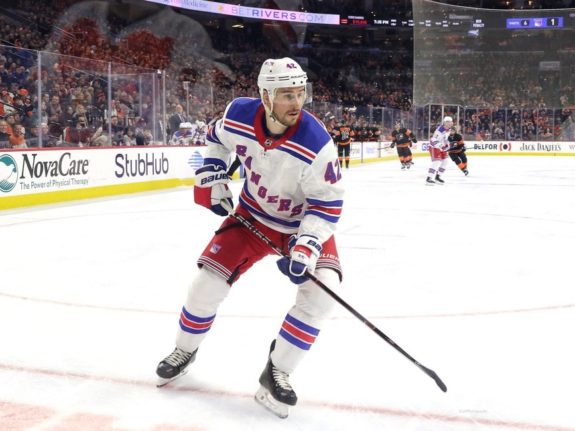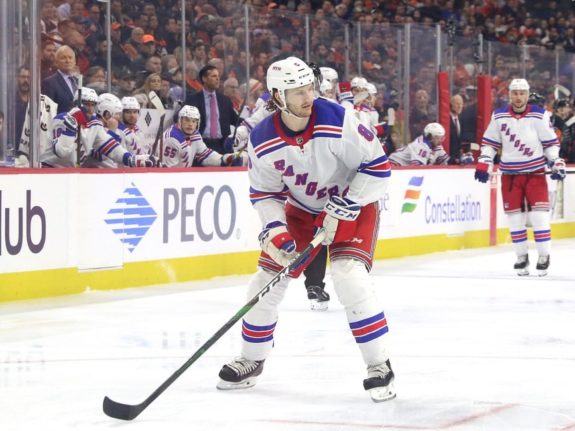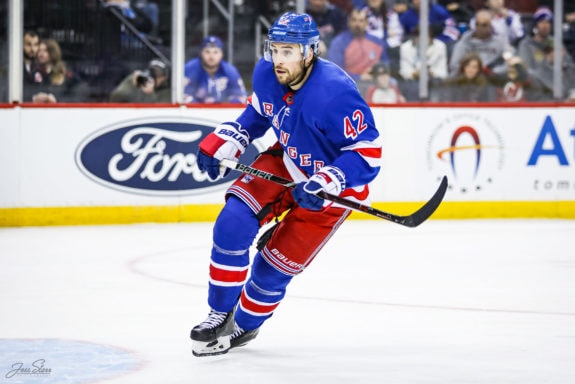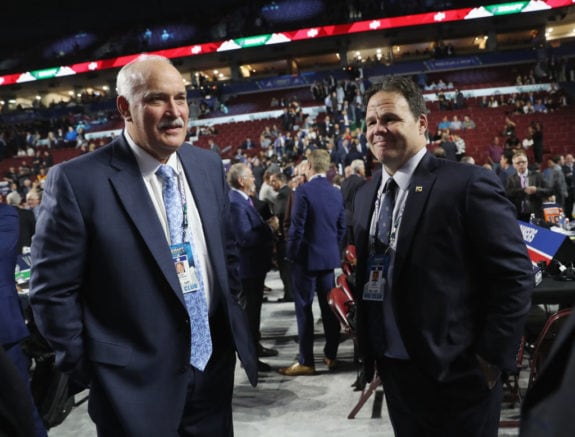Brendan Smith – successful free-agent signing by the New York Rangers four years ago?
Most fans would probably roll their eyes at such a claim. And that’s understandable, given the amount the Blueshirts paid for a player who, over the course of that four-year, $17.4 million contract set to expire at the end of this season, never matched the level of play he achieved in the 2017 playoffs.
Yet if one can get beyond the annual salary, and especially the disastrous first season of that contract, it’s clear that Smith has actually provided more value than many people think – and it’s why the Rangers might even consider bringing him back under the right circumstances.
Smith’s tenure in New York has been largely colored by that first full season with the Rangers, which followed his trade-deadline acquisition from the Detroit Red Wings in Feb. 2017. His outstanding playoff performance that year, filled with physicality and emotion and sound defensive work that led to a plus-8 rating (along with 20 penalty minutes) in 12 games, convinced the front office they had a keeper in the 27th overall pick of the 2007 draft. Smith signed his pricey extension that offseason.

We all know the rest about 2017-18: Smith showed up to training camp out of shape after a summer filled with weddings, including his own; delivered a predictably ugly ensuing performance that ended when he was waived – on his Feb. 8 birthday – and then sent to the AHL; then saw his AHL season end after suffering a broken hand in a fight with teammate Vinni Lettieri in practice the following month.
Smith has come a long way since hitting that rock bottom three years ago. He set about working his way past it starting in 2018-19, when he came into the season in shape and more focused, yet wasn’t much better defensively. But he reinvented himself, embracing coach David Quinn’s request to move to forward while continuing to serve as a defenseman on the first penalty kill unit.
It’s been the past two seasons, however, where Smith’s ability to thrive with flexibility – not to mention his presence in the dressing room – has demonstrated his full importance to the Rangers.
Smith Pairing With Trouba, Miller Proved Crucial
It was Feb. 25, 2020, one day after the Blueshirts traded Brady Skjei to the Carolina Hurricanes, that Quinn moved Smith back to defense, pairing him with Jacob Trouba, who had struggled to find a rhythm – and a consistent defense partner – in his first season on Broadway. The positive effect was immediate for both players.
Trouba, who had been a minus-7 that month, was just a minus-2 over the season’s final nine games with his new blue line partner, exhibiting a long-awaited comfort level with his new team that carried into 2020-21. Smith, back at his natural position after parts of two seasons playing mostly on the fourth forward line, posted an even rating while paired with Trouba. This after he was a healthy scratch for the four previous games and eight of the previous 10.
Smith has kept it up this season. Ticketed as the seventh D-man going into 2020-21 – and the subject of endless demands from fans to buy him out, send him back to Hartford of the AHL or leave him on the taxi squad – Quinn has again called on the 10-year veteran to fill important roles when the need arises. The Jan. 31 banishment of Tony DeAngelo from the roster drew Smith back into the lineup more consistently after being used sparingly in the first six weeks of the season. After missing the first two weeks of February following a collision with the Pittsburgh Penguins’ Brandon Tanev, his services were needed even more.

Trouba suffered an upper-body injury on Feb. 16 in a loss to the New Jersey Devils that was expected to keep him out for 4-6 weeks. Smith made his return in that game, and after Trouba’s defense partner, impressive rookie K’Andre Miller, returned Feb. 20 after a short absence due to his own injury, Quinn paired him with Smith. (From ‘Jacob Trouba ‘Felt Good’ in Return to Rangers Lineup, New York Post, 3/8/21)
Miller has benefited from teaming with Trouba, and Smith was able to duplicate that veteran steadiness for the first-year player until Trouba’s return Sunday after less than three weeks out of action. The Miller-Smith tandem actually bettered the Miller-Trouba pairing in Corsi For percentage (46.04-45.78), and the Rangers scored 10 goals and gave up four with Miller and Smith together, compared to 6 and 6 for Miller and Trouba (courtesy naturalstattrick.com).
With Trouba reunited with Miller, Smith then settled into a third-pair partnership with young Libor Hajek in Sunday’s 5-1 loss to the Pittsburgh Penguins, playing more than 17 minutes. Fans might not have noticed, but for the past year, the still-often maligned Smith has become, to use a bad cliche, a glue guy.
Or maybe calling him duct tape would be the more accurate description.
“I think anytime I get a chance to get in I always try to prove myself,” Smith said. “I don’t really think of why that is that I get that opportunity, I just try to go out and play. I think I’ve done that for a long time now.
“Obviously I love playing, the more minutes I get. It’s fun, I’m excited about it, and you never want to see guys get injured or out for a certain period of time but if it’s more time for me I’m just going to try and prove that I can step in and help the team win.” (From ‘Brendan Smith’s Rocky Rangers Odyssey has Led to K’Andre Miller Mentorship’, New York Post, 2/24/2021)
Spoken like a team-first guy who gets it, especially after four years in which his career path might have made him more fully appreciative of where he is. Smith’s value to the club, however, goes beyond what he does on the ice.
Smith Brings Leadership, Personality to Youthful Roster
The Ontario, Canada native has become one of the leaders for this young group, well-liked by his teammates and providing levity with his offbeat, energetic personality. Assuming Smith is nothing more than a fringe piece of the roster is to underestimate his importance to a Rangers team still early in the process of emerging from an extensive rebuild.
“We’ve all talked about Smitty and the type of person and player he is and how he’s adapted to a bunch of different situations in the two-plus years we’ve been here,” Quinn said in the Post story. “He really handles it like a pro.”
Thusly, the front office might want to hold a brief, quiet celebration amongst themselves when Smith’s $4.35 million cap hit finally disappears this summer – and then think about what it would take to continue the relationship. General manager Jeff Gorton obviously won’t offer close to what he paid before, and a one- or even two-year offer might be bested by other teams, but he would be wise to consider how eagerly and ably Smith has handled his Swiss Army knife role since the nightmare of 2017-18.

Gorton would also do well to remember that he’d be giving Quinn more than a middling talent to keep employing where needed. Smith, whose versatility is enhanced by being equally adept at playing on either side of the defense, is less likely than a true fill-in player to get exposed if he’s forced to sub for a long period of time. As he’s demonstrated this season, the Rangers don’t suffer any significant dropoff when that happens. Overlooking that depth advantage could prove costly.
Would Smith be up for more of the same while staying in a Rangers sweater? It would probably take other teams that could offer a more regular role passing on him before he’d consider coming back. The Blueshirts couldn’t promise him that consistent spot, with more young defensemen on the way to compete for roles on the third pair and the top two pairs looking set going forward. Still, injuries, ineffectiveness and the unexpected always happen. Just look at the Rangers’ defense corps this season.
Rangers Should Consider Retaining Smith as Insurance Policy
Highly regarded young blueliner Nils Lundkvist is expected to finally arrive from Sweden next season, and 2020 first-round pick Braden Schneider might battle him for the right-side spot on the third pair. The organization also boasts a number of promising future options for the left side. What if, however, none of them prove NHL-ready, as Miller stunningly did one season out of college? What if Miller suffers a sophomore slump or more injuries hit?
Should there end up being a lack of interest in Smith around the league as clubs contend with a flat salary cap, the Rangers should be willing to welcome him back. The 32-year-old never turned into the top-four mainstay the Rangers thought they were getting from Detroit, and the GM might not offer him more than the one-year, $1.15 million deal he gave to veteran depth signing Jack Johnson this past offseason.

But he’d be retaining a player who, though Smith looked like a mistake signing at first, has managed to at least partially justify Gorton’s belief in him of late, bringing much more to the table than he’s been given credit for – and one who would actually be missed in 2021-22.